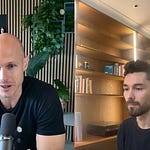In this episode of our CVC series, Andreas Munk Holm and our CVC in-house expert, Jeppe Høier, talk with Marika King, Head of PINC, the corporate venture arm of Paulig.
Marika shares how PINC was born to accelerate core innovation and deliver long-term impact across health, sustainability, and food security. She explains why PINC goes earlier than most CVCs and how they leverage Paulig’s R&D and cultural DNA to validate, support, and scale startups. Marika also offers candid reflections on governance structures, founder dynamics, and how her journey through burnout shaped her values as an investor.
Here’s what’s covered:
03:10 Early Stage Investments and Validation
16:54 Governance and Structure of Pink Ventures
24:00 Lessons in Structuring a Corporate Venture Fund
26:34 Understanding the Role of a CVC
27:03 Misconceptions About CVCs
28:49 Flexibility and Patience in CVC Investments
31:29 The Importance of Founder-Friendly Approaches
Watch it here or add it to your episodes on Apple or Spotify 🎧, with chapters for easy navigation available on the Spotify/Apple episode.
Where operational expertise and innovation work for you.
End-to-end coverage of Fund Admin, Tax, Accounting, Compliance, ESG, and more—enabling you to focus on what matters most: supporting visionaries and maximizing LP returns.
✍️ Show notes
A look at the person behind – Who is Marika King?
I was burnt out at the end of my McK years, and this made me have quite a long and severe depression. It really made me see what matters, that money & status & achievements in other people’s eyes are completely irrelevant. The only thing that matters is to work on something that truly engages you, where you feel you make a difference to someone, and that you contribute.
The other thing is, I have no interest in fake people. I only work with people who are genuine and have a purpose from the heart. This goes for the team as well as the entrepreneurs we invest in. Life is too short to work with boring people without values.
The story behind PINC & Paulig’s corporate venturing strategy
PINC is Paulig’s venture arm, and we invest in early-stage startups in the future food system. Focus on societal, strategic, and financial impacts (health, sustainability, availability/food security). Across the value chain.
Paulig has a very ambitious sustainability strategy, ”sustainability” front runner, and Science-Based Targets. Working with startups and tapping into innovation & drive in these companies speeds up innovation in the corporate world. There are different ways of doing this; working with investments as a CVC is one way.
As a CVC, our primary focus is to find and support really good teams in relevant areas that we believe can succeed, but we also function as a ”portal” for startups to Paulig with relevant ideas, even if we don’t invest.
Key motivations behind creating PINC
PINC was founded for two reasons:
1) To help speed up innovation in the mothership by being at the forefront of what is happening (compare everyday innovation)
2) To have a real impact by contributing to a tastier, healthier, and more sustainable planet. Paulig is family-owned and really cares about these issues; they want to have a great legacy.
It is working! Examples of 1) where things might happen eventually, but faster when we are pushing to get things tested (AI-tool in NPD, Improvin’ digital tool to get better data on climate footprint scope 3 emissions, alternative coffee in blends, etc). With regards to 2) impact remains to be seen, but many of our startups typically have 90% less footprint or other benefits (ingredient companies, like Evodia, Win-win, Kaffe Bueno, etc). Recently, we have invested a lot in climate resilience (OlsAro, Amatera).
How do you determine which startups align with Paulig’s vision and priorities?
We have regular meetings with a core team from Paulig, with one rep from R&D and one from the Sustainability team, where we go through a list of pain points and needs from Paulig so we understand them, and where we discuss what should be tested, etc. We have several ambassadors in various departments from whom we can get immediate feedback on different ideas.
In general, though, our mission and mandate are broader than solving pain points for Paulig. We invest in very early-stage disruptive companies that have the potential to really change the world. Over the years, we have gone more backwards in the value chain towards agtech, in addition to food tech, partly because we wanted to broaden our risk and deal flow, but also because you can have a lot of impact here.
Overall, in PINC, we look at three areas:
How to fix the current system based on agriculture (sustainable farming, crop resilience, data/transparency, alt-ingredients?
How to feed 10 BN people in 2025 in new ways = Post-agriculture = bioreactor food (alt-fats, alt-protein, alt-ingredients made with fermentation, cell culture, enzyme-based platforms, etc).
Circularity of food & material (upcycling, sustainable packaging, etc)
Why PINC backed an AI-enabled tool for soil health.
Yes, this is a very interesting company in the UK called Elaniti. They are decoding the microbiome in the soil to enable actionable insights to farmers to make optimal decisions both for soil health and yield. Farmers are under a lot of pressure to reduce chemical inputs, both in terms of fertilizers and pest control, but are still expected to produce the same yield. Understanding the effect of the microbes in the soil provides a missing piece of the puzzle here, where sometimes you don't need as much input to get the same yield, or sometimes you should not plant a crop at all in a particular year, but rather plant something else.
At PINC, we believe soil health is key for the long-term sustainability of agriculture, and Elaniti is unique in what they are trying to do. We have the mandate to support these types of ventures that are overall good for agriculture and the world, but it helps that the first POC is in winter wheat, and wheat is one of the most important crops for Paulig; we sell 2.5 billion tortillas per year, made mostly from wheat!
The structure & governance of PINC
Some CVCs get cut when EBITDAs are challenged, and it becomes a less reliable partner for entrepreneurs and other investors. Having PINC report straight to the board signals that there is a long-term commitment here that is not dependent on yearly ups and downs in profit.
The most important vehicle, though, is the Investment Committee, where we make all decisions. The composition is crucial to get the right mix of important Paulig involvement and external competence. As an example, we have the Deputy Chair and family representative, Edi Paulig, as our Chair, and the CFO, Juha Väre, as our Paulig people, and then we have two external representatives, Timo from Inventure and Tatiana from Kinnevik, so a very professional and competent IC.
Lessons learned about structuring and governing a corporate venture fund
You need to drive your own agenda/form your own strategy, i.e., what you are doing and why – no one will typically do that for you, even though they might be supportive of the idea. If you convince yourself, you can convince anyone:)
You need a cumulative mandate, not yearly budgets, which don’t make sense for how investments work
The IC needs pre-planned meetings every 2 weeks. This ensures we have the ability to make fast decisions, and if we don't need the mtgs, we just cancel them.
Also, ensuring everyone is well informed about plans and progress, including 1) regular updates to Paulig Leadership team, 2) making sure that the CVC is on the agenda once a year in the board and in-between is on the board mtg agenda for updates from a board person that holds the responsbility (our case Edi, the deputy chair)
The biggest lessons learned after the first five-year mandate
On a personal level, I feel like my learning curve starts over every day😊 I didn’t really come from investor experience, so a couple of things about that:
The importance of a good consortium (don’t go alone anymore, etc)
To trust your analysis/judgment and go for it, sometimes even though no one else has the guts (“too early”). Nobody knows what will work in the end. Some investors claim to invest in early-stage startups but still want all the proof points of a later-stage startup.
Another thing that I can see is how much corporates can add, not just Pauli,g but other corporates and CVCs on our portfolio companies’ cap tables. I am a huge fan of corporate investors as long as they understand the mechanics and dynamics of minority investments.
How does corporate venturing operate compared to traditional VC?
Oftentimes, we have more patience to follow a company that might not be investable at first, either because there is a strategic synergy or just simply because we think the company is unique and could have a huge societal impact. I feel like many of our fellow VCs have more pressure to close a certain number of deals and have a certain target in dealflow, making it, etc, that makes them say no to many startups because it takes more effort to look into them. We make time for that effort when we really care. Hence, sometimes we invest in cases we have followed for 1-2 or even 3 years, when they have done lots of work to become investable.
What type of external partnerships have been most valuable for PINC?
The agrifood ecosystem is a great place to be, where almost everyone is very collaborative. We love our co-investors like Nordic Foodtech VC, Mudcake, Future Food Fund, Thia Ventures, Peakbridge, Pale Blue Dot, Almi, Agfunder, but also the Spinout arms from Universities like Chalmers Ventures, GU Ventures, etc. Public or non-profit institutions supporting R&D and early startups are super important, like BII in Denmark, VIB in Belgium, and EIT FAN. Incubators like StartLife in NL, Carbon 13 in the UK, Biotope, MassChallenge, and FoodBytes. So many! And of course, networks & conferences like Hack have played a crucial role in building the ecosystem.
How does PINC collaborate with other corporate venture arms or food industry players?
We have relationships with many other CVCs, both in food and agtech. We also build relationships with international food & ingredient companies, in particular via our partnership with EIT FAN (Food Accelerator Network) every year, where many corporations participate. It is important for us to be able to test and validate the market with players other than Paulig.
If you could reshape PINC’s mandate or strategy in any way, what would you change?
It is always easy to ask for more money, but I actually think it is good not to have too much, it makes you prioritize and make hard decisions
CVC trends in the food industry
Development has been professional CVCs that function like VCs in many ways, arm's length/independent, and this is a good thing. Also, high demands on solid financial business cases are important since otherwise you invest in companies that won’t make it, bad for everyone. This development will continue, since this is what works.
Sometimes CVCs have longer timelines than VCs, and this is sometimes needed in agrifood tech, where things take longer (lots of it is deeptech btw). I think we will see more CVCs working together and also finding other financing solutions, either from corporates, family offices, grouping around longer timelines, and joining forces with alternative debt solutions or new innovative financing.
Advice for other corporate leaders looking to enter the venture space
Think about why you do it. What is it that you want to achieve, really (as opposed to the fact that it sounds cool to have a CVC unit)
Give it the right mandate & governance structure
Give employees an incentive structure related to value creation/exits. They likely have much lower salaries than at the fellow CVCs they collaborate with. This is usually okay since they are likely to be more values-driven, but the discrepancy can't be too great. Since you do not have a fund, you can't have ”carry,” but you can invent other ways of getting a type of bonus related to net value creation.
Some things are made for platforms - music, cabs & pizzas. But fund solutions aren’t one of them. Their individual client focus and regulation-first approach is your guarantee for flexible solutions accommodative to a broad range of deal and client specifics. The kicker? Prices that match any of the shelf-products in the market.
🤗 Join the EUVC Community
Looking for niche, high-quality experiences that prioritize depth over breadth? Consider joining our community focused on delivering content tailored to the experienced VC. Here’s what you can look forward to as a member:
Exclusive Access & Discounts: Priority access to masterclasses with leading GPs & LPs, available on a first-come, first-served basis.
On-Demand Content: A platform with sessions you can access anytime, anywhere, complete with presentations, templates, and other resources.
Interactive AMAs: Engage directly with top GPs and LPs in exclusive small group sessions — entirely free for community members.
Join us at the EUVC Summit & Awards Show

Adventures and Deep Connection Await 💞
Step beyond the ordinary into a retreat that challenges and transforms you—as a partner and as an individual. Ten couples will embark on an adventure of reflection, connection, and shared resilience, guided by nature and a like-minded community. Traverse mountains, navigate the sea, and embrace stillness under the Corsican sky. This is not an escape—it’s a chance to be fully present, together, in adventure & in life.
🗓️ The VC Conferences You Can’t Miss
There are some events that just have to be on the calendar. Here’s our list, hit us up if you’re going, we’d love to meet!
0100 Emerging Europe 2025 | 📆 14-16 May 2025 | 🇭🇺 Budapest, Hungary
GITEX Europe 2025 | 📆 23 - 25 May 2025 | 🇩🇪 Berlin, Germany














